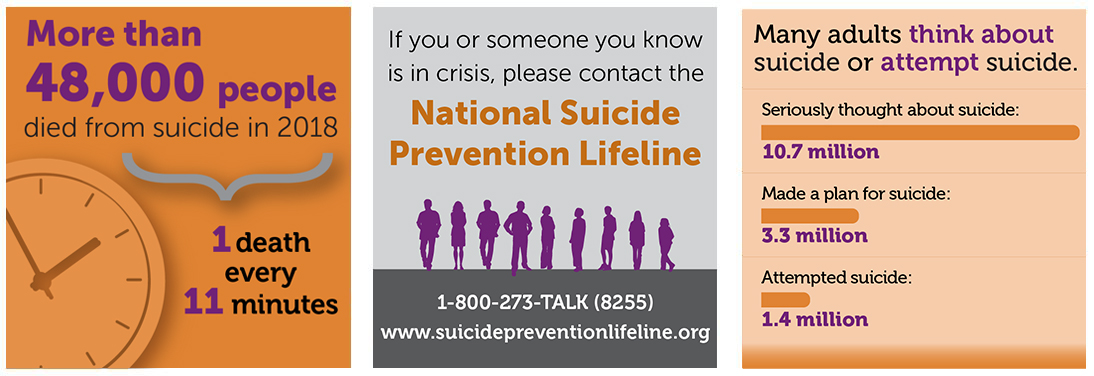Preventing Suicide

Suicide is death caused by injuring oneself with the intent to die. A suicide attempt is when someone harms themselves with the intent to end their life, but they do not die as a result of their actions.1
Several factors can increase the risk for suicide and protect against it. Suicide is connected to other forms of injury and violence, and causes serious health and economic consequences. For example, suicide risk is higher among people who have experienced violence, including child abuse, bullying, or sexual violence. Protective factors like family and community support, or, “connectedness,” and easy access to health care can decrease the risk for suicidal thoughts and behavior.2
Suicide and other forms of violence can be prevented by using a public health approach that addresses risk and protective factors for multiple types of violence.2
Suicide is a large and growing public health problem. Suicide is the 10th leading cause of death in the United States.3 It was responsible for more than 48,000 deaths in 2018, resulting in about one death every 11 minutes.3 Every year, many more people think about or attempt suicide than die by suicide. In 2018, 10.7 million American adults seriously thought about suicide, 3.3 million made a plan, and 1.4 million attempted suicide.4
Suicide affects all ages. Suicide is a problem throughout the life span. It is the second leading cause of death for people 10 to 34 years of age, the fourth leading cause among people 35 to 54 years of age, and the eighth leading cause among people 55 to 64 years of age.3
Some groups have higher rates of suicide than others. Suicide rates vary by race/ethnicity, age, and other population characteristics, with the highest rates across the life span occurring among non-Hispanic American Indian/Alaska Native and non-Hispanic White populations.5 Other Americans disproportionately impacted by suicide include Veterans and other military personnel and workers in certain occupational groups like construction and the arts, design, entertainment, sports, and media fields.5,6 Sexual minority youth bear a large burden as well, and experience increased suicidal ideation and behavior compared to their non-sexual minority peers.5
See Suicide Resources for articles, publications, and data sources for suicide.
In addition to the number of people who are injured or die, suicide also affects the health of others and the community. When people die by suicide, their family and friends can experience shock, anger, guilt, and depression. The economic toll of suicide on society is immense as well. Suicides and suicide attempts cost the nation almost $70 billion per year in lifetime medical and work-loss costs alone.3
People who attempt suicide and survive may experience serious injuries, such as broken bones or brain injury. These injuries can have long-term effects on their health. People who survive suicide attempts may also experience depression and other mental health problems.7
Many other people are impacted by knowing someone who dies or by personally experiencing suicidal thoughts.7 Additionally, being a survivor or someone with lived experience increases one’s risk of suicide.
CDC has developed a technical package, Preventing Suicide: A Technical Package of Policy, Programs, and Practices pdf icon[6.11 MB, 62 Pages, 508] that provides information on the best available evidence for suicide prevention. Also available in Spanish pdf icon[34 MB, 64 Pages, 508]. The technical package can be used to inform a comprehensive, multi-level and multi-sectoral approach within communities and states. It includes strategies to prevent suicide in the first place, by decreasing suicide risk factors and increasing protective factors. Strategies range from a focus on the whole population regardless of risk to strategies designed to support people at highest risk. This technical package includes strategies and approaches that go beyond individual behavior change to better address factors impacting communities and populations.
1. Crosby AE, Ortega L, Melanson C. Self-directed violence surveillance: uniform definitions and recommended data elements, version 1.0. (2011) Atlanta, GA: Centers for Disease Control and Prevention, National Center for Injury Prevention and Control.
2. CDC. Preventing multiple forms of violence: A strategic vision for connecting the dots. (2016). Atlanta, GA: National Center for Injury Prevention and Control, Centers for Disease Control and Prevention.
3. CDC. Web-based Injury Statistics Query and Reporting System (WISQARS). (2020) Atlanta, GA: National Center for Injury Prevention and Control. https://www.cdc.gov/injury/wisqars/index.html
4. Substance Abuse and Mental Health Services Administration. (2019) Key substance use and mental health indicators in the United States: Results from the 2018 National Survey on Drug Use and Health (HHS Publication No. PEP19-5068, NSDUH Series H-54). Rockville, MD: Center for Behavioral Health Statistics and Quality, Substance Abuse and Mental Health Services Administration. Retrieved from https://www. samhsa.gov/data/
5. Stone DM, Holland KM, Bartholow B, Crosby AE, Davis S, Wilkins N. (2017) Preventing suicide: A technical package of policies, programs, and practices. Atlanta, GA: National Center for Injury Prevention and Control, Centers for Disease Control and Prevention.
6. Peterson C, Stone DM, Marsh SM, et al. Suicide Rates by Major Occupational Group — 17 States, 2012 and 2015. MMWR Morb Mortal Wkly Rep 2018;67:1253– 1260. DOI: http://dx.doi.org/10.15585/mmwr. mm6745a1
7. Chapman AL, Dixon-Gordon KL. (2007) Emotional antecedents and consequences of deliberate self-harm and suicide attempts. Suicide & Life Threatening Behavior; 37(5):543-552.

